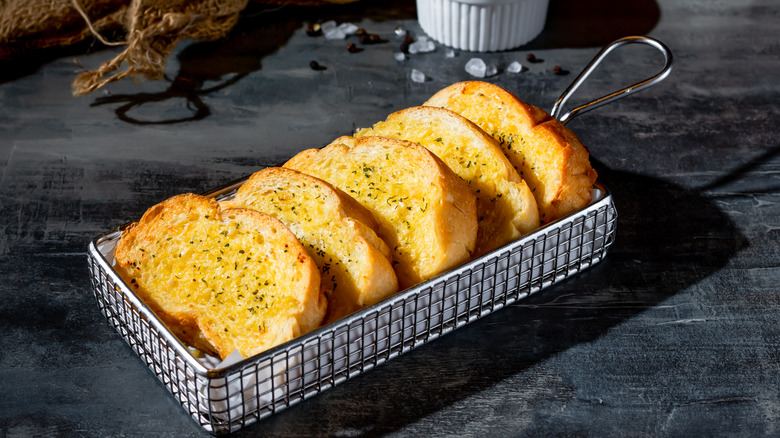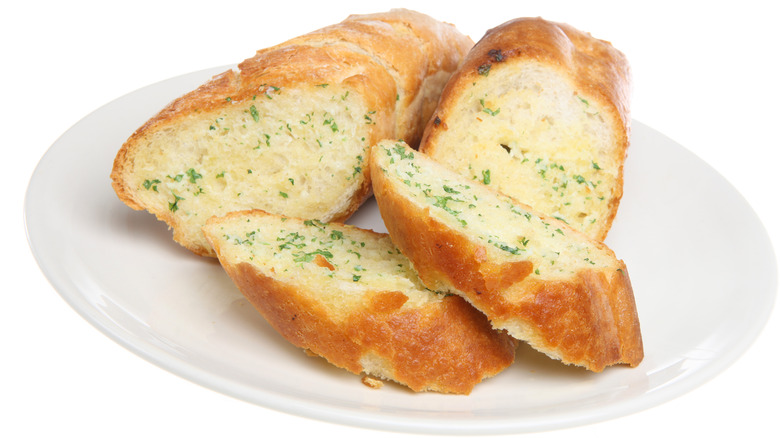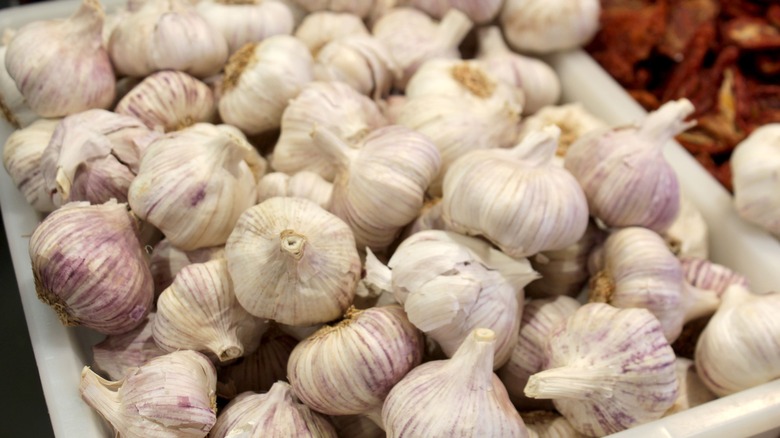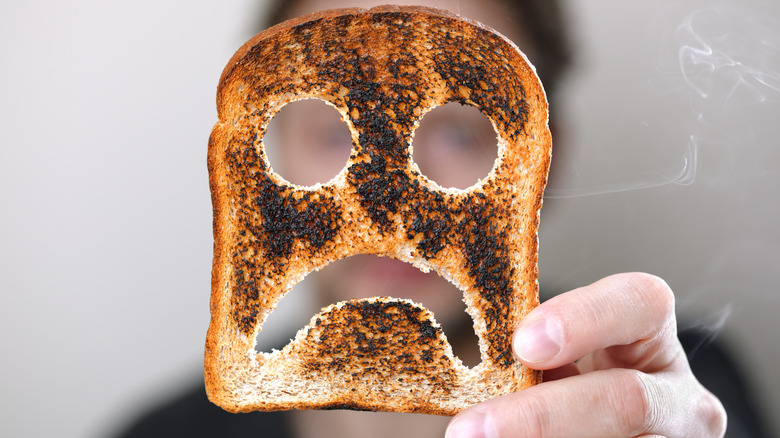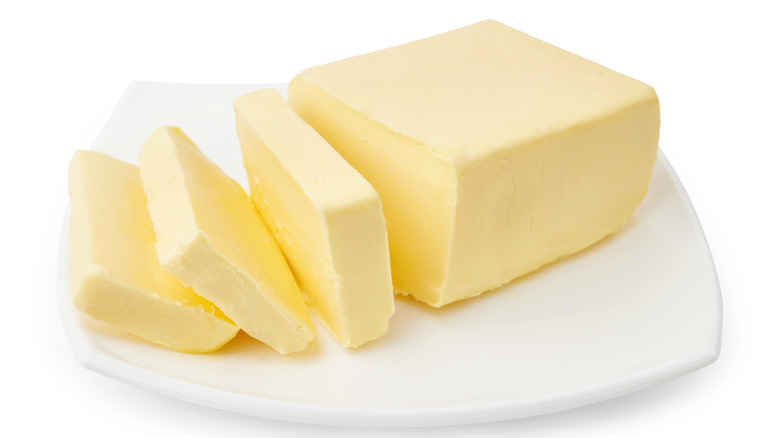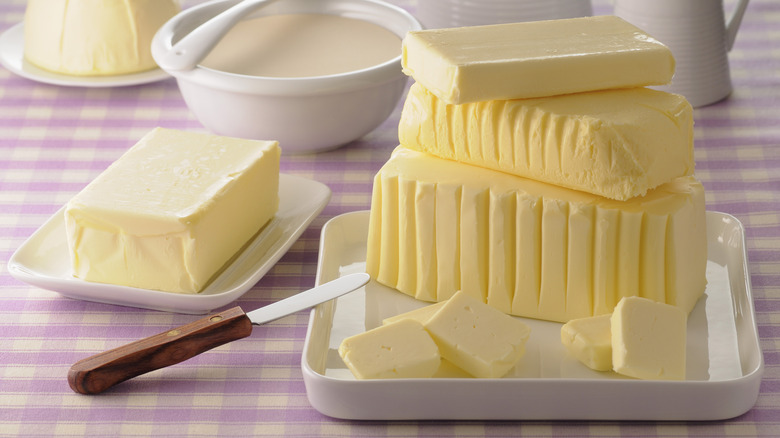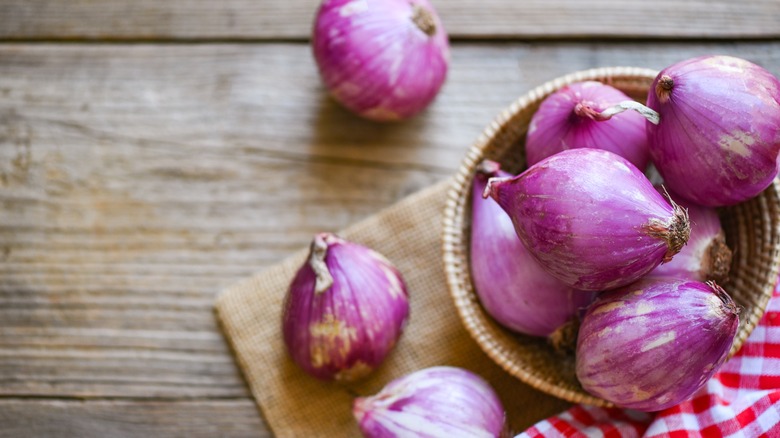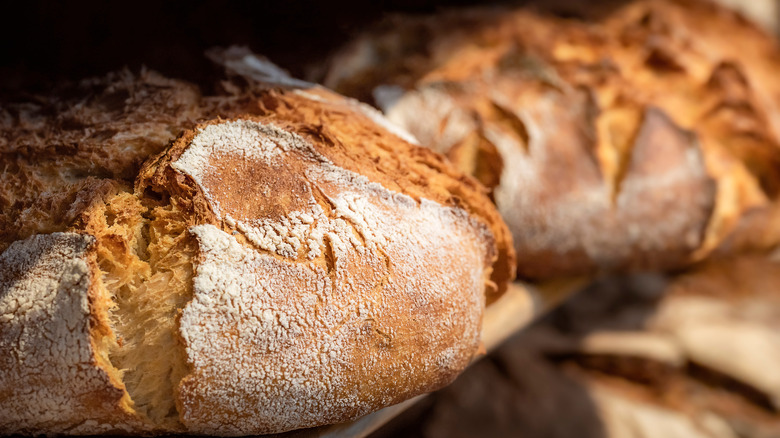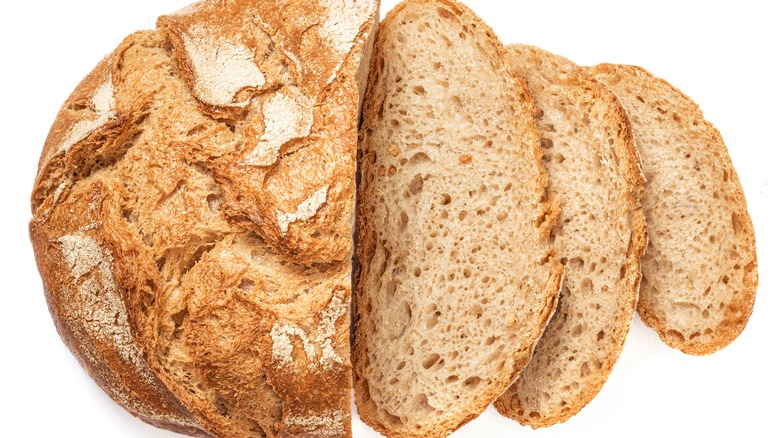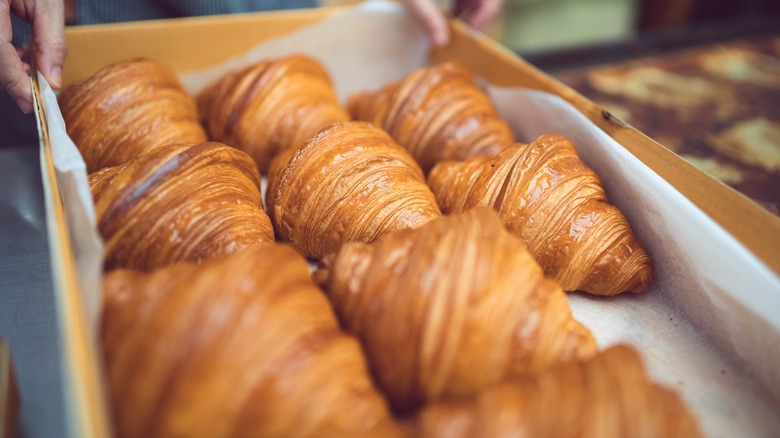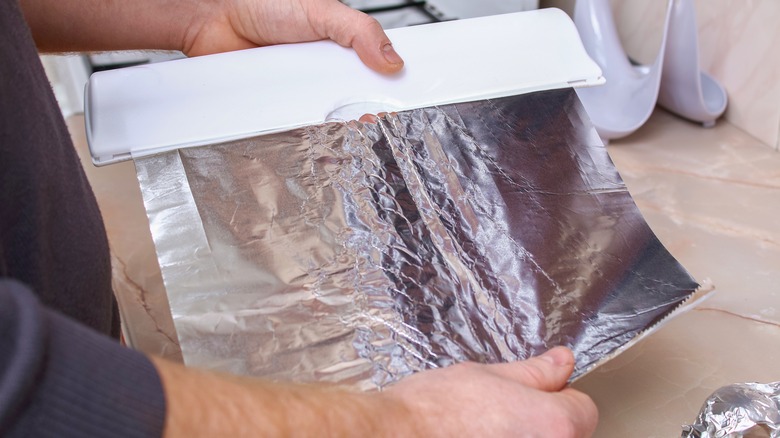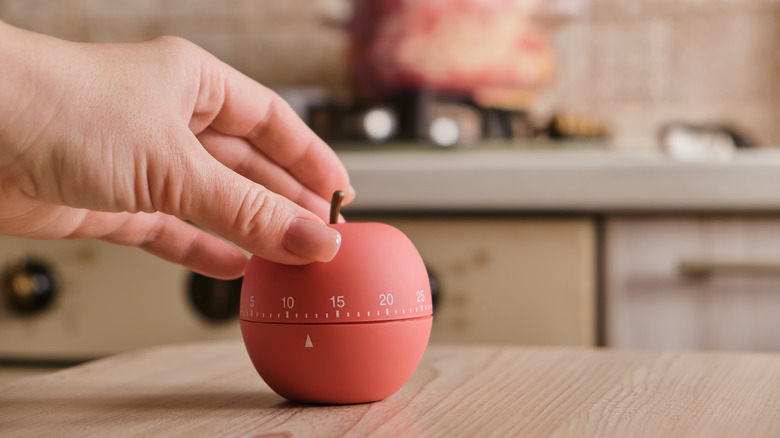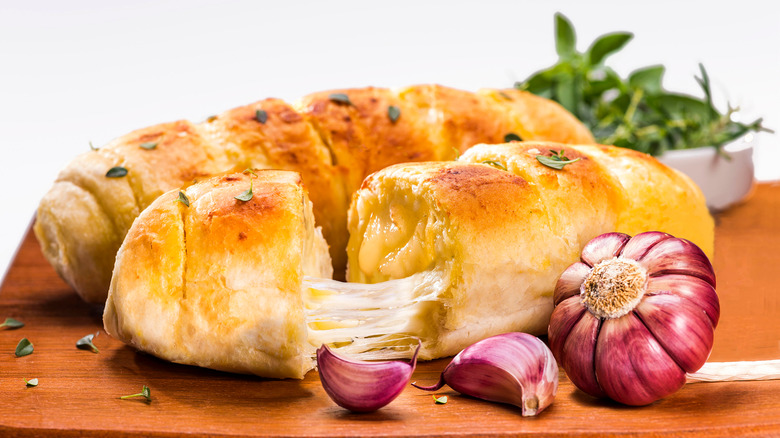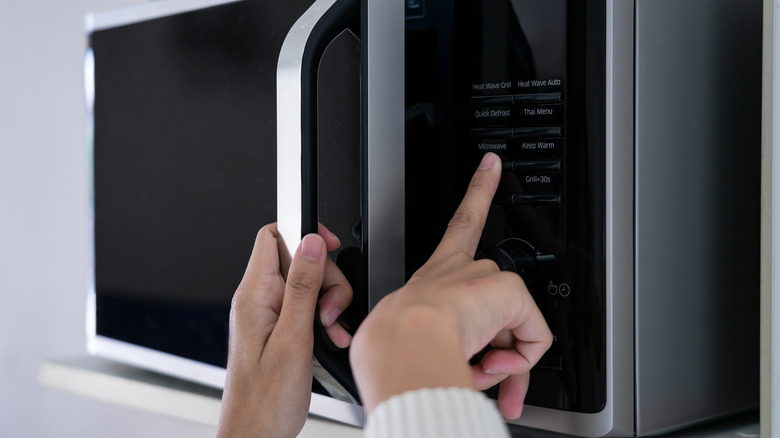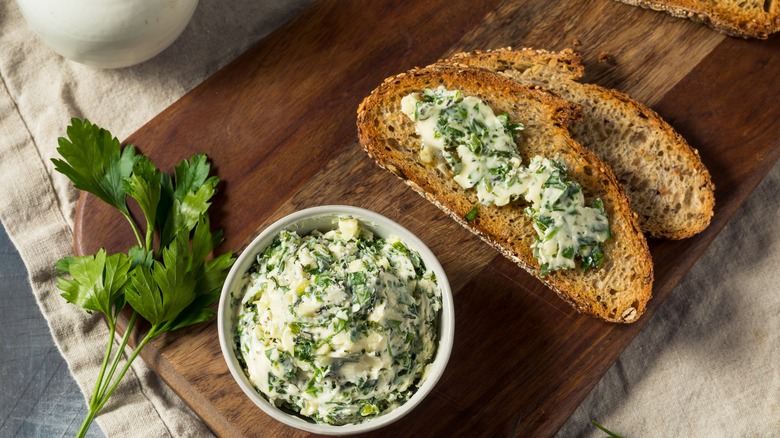14 Tips You Need When Making Homemade Garlic Bread
Nothing brings a meal together like garlic bread. Whether you picked up some pizza on the way home from work, you whipped up a bowl of spaghetti for the family, or you are simmering a hearty stew on the stove, there's just something about garlic bread that manages to put a smile on everyone's face. The way that buttery, garlic, crispy bread, hot out of the oven, blends everything together is nothing short of magical.
The ingredients are generally simple, and yet it often steals the show from what it is served with. Your children might not want another helping of pasta, but you better believe they are grabbing for another slice of warm garlic bread. It's like there's some kind of power emulating from that loaf of bread in the middle of the table. Everyone can smell it, and everyone wants it. It doesn't take much to whip up quality garlic bread, but if you're interested in elevating this garlic bread to an entirely different level, here are a handful of tips you absolutely need to follow in order to enhance your garlic bread.
Start with the right bread
Sure, technically you can make "garlic bread" with just about any bread you have on hand. Wonderbread, whole grain, that suspicious loaf you decided to grab from Whole Foods Market but you still have no clue what it actually is, or what it's coated with (did something just crawl on top!?). So, yes, you can use all of those types of bread, but if you really want to amplify your final product and serve up the best possible garlic bread imaginable, you'll want to focus on one of a few very specific kinds of bread.
For the perfect garlic bread, you want to have a crunchy exterior and a soft, chewy interior. That pretty much means avoiding the row of bread in your big box grocery store, because all of that is way too fluffy and pumped up with all kinds of sugars and chemicals. No, for this, you want to go to the bakery section. Here, you'll find freshly baked bread with crunchy crusts and soft, tender insides. Of all the kinds available, the bread to consider includes French baguettes, Ciabatta loaves, or sourdough. You can also go with an Italian loaf for a homemade garlic bread recipe, as well.
Use real garlic
Dealing with peeling and crushing and mincing garlic can be a pain, not to mention it leaves your fingers smelling like garlic for days. Ever go on a date after prepping some garlic for a nice dinner you have cooking for them? Nothing like giving them a hug and smelling the waft of garlic permeating up from your fingertips. They better like the aroma of garlic, because there's no getting that off of your hands (unless you want to break out the special orange mechanic soap). With all that work and hassle, we wouldn't blame you if, when walking through the grocery store, you eyeball that massive jar of minced garlic. It would make life so much easier, wouldn't it? Of course it would. You could just dip a spoon in the jar and add it to your garlic bread. All without leaving your skin stained with the tears of chopped garlic.
The problem with all of this though is that minced garlic sitting in a jar will never bring the same level of flavor as a freshly crushed and minced clove. This is because jarred garlic is pasteurized and left in a liquid so it can remain "fresh." This ends up prying very important flavor away from it. So, yes, while that jar of minced garlic is a time saver, it is also a flavor waster, so just accept your fingers are going to smell like garlic and embrace better-tasting garlic bread.
Don't overcook your garlic bread
There's no need to cry over burnt toast, but we might break down in a fit of sadness if there is burnt garlic bread. Sometimes, depending on the kind of bread you're using, you might be able to salvage the bread by sheering away the crust, as the interior of the bread might still be okay. But even then, it's not as good as it could have been. This is why you need to be vigilant in standing guard by the oven. Or set a cooking timer. Whatever works for you (we like to pretend we're standing guard for something very, very valuable within the oven from time to time. Nobody said you couldn't have a little kid-like fun as an adult).
When you overcook garlic, you run the risk of having all that delicious flavor going south. As garlic burns, it will begin to taste bitter (which is a great tip for cooking with garlic in general). So, if your garlic bread is tasting on the bitter side it likely is because you're overcooking the bread in the oven. So, the next time around, pop that garlic bread out of the oven sooner instead of later.
Use unsalted butter
Garlic bread doesn't require many ingredients. However, chances are you'll be adding your own salt to the recipe. Or, if not, many of the other ingredients within the garlic bread will bring along additional salt. Either way, garlic bread can quickly become incredibly salty if you are not careful, so it is always better to have total control of the salt (or, at the very least, as much control over the salt as possible).
While you can't control how much salt comes in any additions to the garlic bread, such as cheese or sauces, you can control the amount of salt in the butter you are using. Unless salted butter is the only ingredient in a particular dish, we almost always recommend using unsalted butter to give you that additional level of control. In the kitchen, it is almost always about your control over the food. And while garlic bread is simple, you still want to maintain your iron grip on the sodium levels you're working with, lest it be so salty you can't even eat it.
Soften your butter
First of all, you don't need to keep butter in the fridge. Yes, it is dairy-based, but butter will keep outside of the fridge for weeks. Certain things are able to remain outside of the fridge for longer periods of time, like soy sauce. Sure, the bottle says "refrigerate after opening," but with the sheer amount of salt in soy sauce, the bottles can remain outside for weeks, if not longer. Just make sure to keep your butter inside a butter container, to keep out dust, kid fingers, and the cat from batting around the creamy topping.
Keeping the butter out of the fridge will help ensure your butter is always ready for spreading. If, however, you do keep butter inside the refrigerator, you will want to pull it out and heat it up until it's soft. Using butter right out of the fridge runs the risk of tearing up the interior of your garlic bread.
Add roasted shallots
Garlic bread is pretty basic when it comes to ingredients. However, one ingredient that is often overlooked (and shouldn't be) is roasting up some shallots to add to your butter mixture. Shallots are the sweet and savory cousin to onions. Adding this will help elevate your butter mixture to an entirely new level, all without overpowering the bread.
We will get into a few other possible add-on ideas you can take advantage of later on in our little presentation here. After all, there are just so many fantastic ways to jazz up your garlic bread (did you picture us doing "jazz hands"? If so, good). But for now, try out the roasted shallots. The vegetable goes beautifully with the garlic, especially if you stuck to our previous instructions and used fresh garlic and not the jarred stuff. It's always a good idea to stick with all fresh ingredients because if one is fresh and one is jarred, the fresh will likely outweigh the flavor and take over the flavor profile.
Consider going crustless
It might feel a bit like stepping out of the house and realizing you forgot to put on any clothes, but shedding the bread's crust may end up being a total game changer. Especially if you have a house full of kids who love to chow through the softer portion of the bread, but then leave you with a mess of untouched crusts laying all over their dinner plates. When that is the case, why not just do away with the crust altogether and skip the mess?
Now, if that extra crunch crust is something you love, by all means, skip this step. However, if you want to get right to the good chewy center, this is for you. With a large, unsliced bread (an Italian loaf will work better for this), remove the crust, cut the bread into strips, then coat the pieces in a butter, garlic, salt, and Italian seasoning mixture. This allows you to have 360-degrees of buttery-garlic goodness.
Slice your bread to the right thickness
Okay, so you picked up the loaf of bread from the bakery, and you have the garlic butter spread all whipped up and ready to go, but your brain is locking up. Just how large are the cuts supposed to be? You think back to all the garlic bread you've had in your life, and nothing is ringing a bell. Can it be too thick? Can it be too thin?
A 1-inch thick piece of bread is an ideal thickness. Anything thinner and you basically have a slice of Wonder bread, and anything thicker and your jaw will need to work overtime whenever you take a bite. One-inch thick bread is the sweet spot. You can, of course, cut the bread all the way through, although we do like the old-fashioned method of leaving the bottom of the loaf connected, so you can then tear it off when the bread is ready to enjoy.
Consider using a croissant
Are you growing tired of the same old-same old garlic bread? Gasp! Okay, now that we're over our shock a little bit, allow us to help you out a little. Sorry, hearing someone was tired of garlic bread gave us quite a start. But, thankfully, we have a few tricks up our sleeves we can help you with. It's enough to still give you that garlic bread taste while introducing you to something a bit different.
If you want to switch it up a little bit to a baked good that is lighter and fluffy, consider using a croissant. Most garlic bread is pretty dense, which does work well if you're mopping up heavy pasta sauce. However, there might be times you want the taste of garlic bread, but with something lighter and airy. If that is the case, consider using a large, fluffy croissant to transform your next batch of garlic bread. You'll need to tweak the bake time for this as it isn't as thick or dense as Italian bread, but it might be the lighter alternative you've been searching for.
Want to get really wanky with it? Why not opt for the Argentina medialuna, which is similar to a croissant, but with just a subtly sweet glaze on top? Perhaps something sweet and salty is exactly what you're looking for.
Wrap garlic bread in tin foil
Technically, you don't need to wrap your garlic bread in tin foil when baking it in the oven, but you really should. Doing so will ensure your bread is going to cook more evenly. It will also help keep the interior somewhat moist. Totally dry bread has the crunch of a crouton, and, while we love croutons (sometimes it's the best part of a salad), there needs to be some level of moisture remaining on the interior. So wrap that garlic bread up to help lock in moisture.
There is a reason why the garlic bread sold in the freezer section comes in its own bag of tin foil. You're actually supposed to slide the entire tin foil bag into the oven and use it exactly as you would regular tin foil and a freshly baked loaf of bread. We're not suggesting you go out and buy the freezer bread, but every once in a while, those freezer brand companies absolutely know what they are doing.
Know your baking time
Garlic bread bake time is so important because you're dealing with retaining the moisture within the bread. You're not trying to zap off all the watery life inside of it. That would defeat the purpose. It needs to be crispy on the exterior while crunchy-soft on the interior.
If you're going with the standard French baguette, Italian loaf, or something along this width and mass, you can bake your bread for around 15 minutes at 400 degrees Fahrenheit, especially for ultra-crispy edges. Following that, you'll want to remove the bread from the tin foil and bake for another five minutes. The last five minutes help crisp up the exterior while maintaining that slightly moist (but still crunchy) interior. Now, if you're using another kind of bread, this is a good starting point, but you might need to tweak it a bit, so check the bread a few minutes before the 15-minute mark to see how it's holding up and go from there.
Consider adding cheese
Quick, what is the one thing you can add to anything to make it better? No, you can't say salt. If you guessed cheese, you're right on the money. Few things in this world make just about everything taste better like cheese. If you can convince a four-year-old to eat their broccoli by smothering it in cheddar cheese, there really isn't anything it can't do (except maybe on ice cream, but let's be real. We'd absolutely try it if someone handed us a cone and said to taste it).
The same is true with garlic bread. Maybe the only thing better than garlic bread is cheesy garlic bread. If you already are serving up a meal loaded with cheese, you might want to hold back. But if not, or if you just love cheese, consider adding cheese to your butter and garlic mixture. Grated parmesan is probably the easiest cheese to use, but you can use whatever cheese you might like. Using cheese is another reason why you need to use unsalted butter. Most cheeses are already pretty salty, and combining them with salted butter will run the risk of having too much salt in the bread.
Don't microwave your garlic bread
Maybe you're in a bit of a pinch and you need the garlic bread ready ASAP. You left the loaf on the counter, and yet your in-laws just texted you that they are around the corner and starving. In a cold sweat, you turn around and see it. The uncooked loaf of bread, sitting there, glistening under the light. In that case, we understand, and we won't hold it against you. Sometimes you just have to cut a few corners to stay on schedule, and the microwave is the answer.
But here's the thing. Maintaining that little bit of moisture within the bread while keeping the exterior crispy is what makes the garlic bread texture so exceptional. You run the risk of losing that when you microwave the bread. So, can you microwave garlic bread? Yes. Should you? Not if you can avoid it. This is a big reason why you need to use tin foil in the oven, as it helps with moisture. So, if you have any kind of wiggle room with your schedule, always bake the garlic bread.
You can get creative with your garlic butter spread
Most recipes will call for a garlic and butter spread, possibly with some salt and Italian herb additions. It's straight to the point, keeps it simple, familiar, and, possibly most important, cheap. And if you want great-tasting garlic bread, by all means, follow the recipe, because what you pull out of the oven will be tasty and delicious.
But with garlic bread, you can get as creative as you like. Bread already is a blank canvas, and while you're applying a little bit of pigment in the form of butter and garlic, there's so much more flavor potential. Maybe you want to crank up the spice profile of your garlic bread. Why not bust out the red pepper flakes, or even some squirts from your favorite hot sauce bottle? You can go a little more high-end and apply some pesto, which can be a fantastically delicious add-on to what the recipe already calls for. Nobody said you couldn't piggyback off the current recipe to customize your own. Heck, why not add a bit of taco seasoning to go along with that margherita pizza you're about to enjoy? Nothing is off-limits when it comes to your very own garlic bread.
